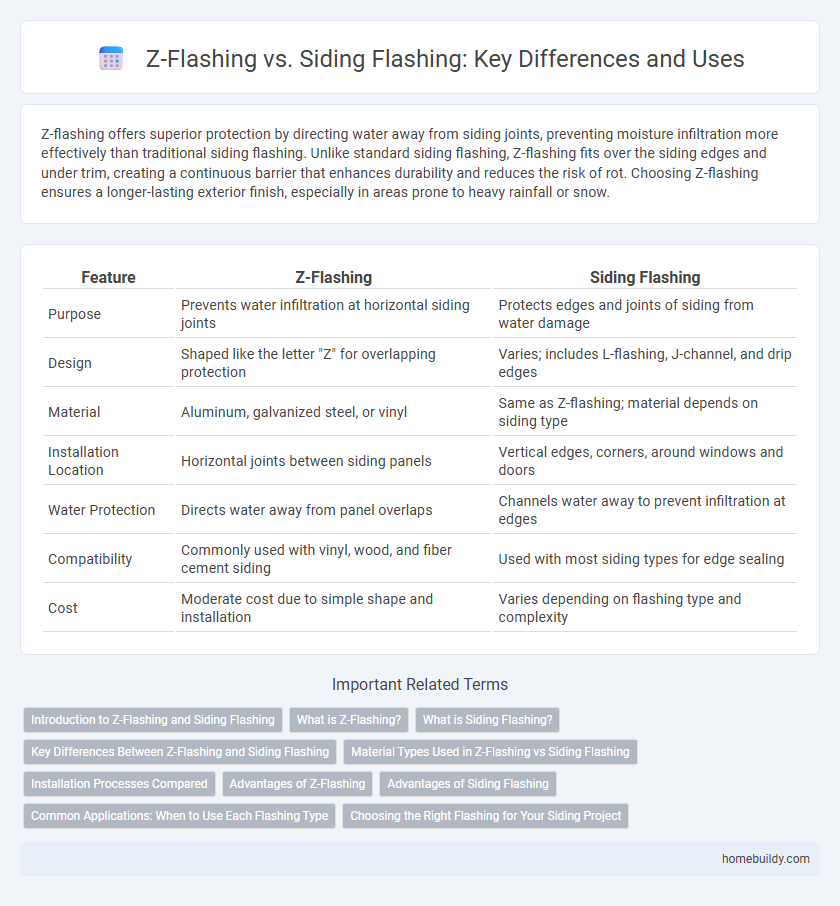Z-flashing offers superior protection by directing water away from siding joints, preventing moisture infiltration more effectively than traditional siding flashing. Unlike standard siding flashing, Z-flashing fits over the siding edges and under trim, creating a continuous barrier that enhances durability and reduces the risk of rot. Choosing Z-flashing ensures a longer-lasting exterior finish, especially in areas prone to heavy rainfall or snow.
Table of Comparison
| Feature | Z-Flashing | Siding Flashing |
|---|---|---|
| Purpose | Prevents water infiltration at horizontal siding joints | Protects edges and joints of siding from water damage |
| Design | Shaped like the letter "Z" for overlapping protection | Varies; includes L-flashing, J-channel, and drip edges |
| Material | Aluminum, galvanized steel, or vinyl | Same as Z-flashing; material depends on siding type |
| Installation Location | Horizontal joints between siding panels | Vertical edges, corners, around windows and doors |
| Water Protection | Directs water away from panel overlaps | Channels water away to prevent infiltration at edges |
| Compatibility | Commonly used with vinyl, wood, and fiber cement siding | Used with most siding types for edge sealing |
| Cost | Moderate cost due to simple shape and installation | Varies depending on flashing type and complexity |
Introduction to Z-Flashing and Siding Flashing
Z-flashing is a metal or vinyl strip shaped like the letter "Z" designed to prevent water infiltration at horizontal siding joints by directing moisture away from the wall assembly. Siding flashing broadly refers to various metal or plastic flashings installed around siding elements, including window and door openings, to protect against water penetration and enhance durability. Understanding the specific function of Z-flashing within the wider category of siding flashing helps ensure effective moisture management in exterior wall systems.
What is Z-Flashing?
Z-flashing is a metal or vinyl flashing shaped like the letter "Z" used to direct water away from building exterior surfaces, particularly where horizontal siding panels overlap. It prevents moisture infiltration by channeling water downward and out, protecting wood framing and sheathing from rot and damage. Compared to siding flashing, which is typically flat or L-shaped, Z-flashing provides enhanced drainage capabilities for cladding joints.
What is Siding Flashing?
Siding flashing is a protective material installed where siding meets other building elements, designed to prevent water infiltration and direct moisture away from the structure. Typically made from metal or flexible flashing tape, it seals gaps and overlaps, ensuring structural durability and reducing the risk of mold or rot. Unlike Z-flashing, which specifically fits over horizontal seams, siding flashing can be customized for various joints, corners, and transitions in exterior wall systems.
Key Differences Between Z-Flashing and Siding Flashing
Z-flashing is a metal strip shaped like a "Z" used primarily to cover horizontal lap joints on exterior siding, preventing water infiltration by directing moisture away from the wall. In contrast, siding flashing encompasses a broader category of materials designed to protect various siding edges and transitions, such as window and door openings, valleys, and corners. The key difference lies in Z-flashing's specific profile and targeted application on horizontal joints, whereas siding flashing includes multiple types tailored for diverse siding protection needs.
Material Types Used in Z-Flashing vs Siding Flashing
Z-flashing typically uses aluminum or galvanized steel due to their durability and resistance to rust, ensuring long-term protection against water infiltration. Siding flashing, on the other hand, often incorporates vinyl or flexible rubberized asphalt materials, providing adaptability to various siding profiles and easier installation. Material selection for Z-flashing versus siding flashing significantly impacts performance, weather resistance, and compatibility with building exteriors.
Installation Processes Compared
Z-flashing installation involves securing the metal strip over horizontal seams, ensuring water diverts away from the siding by tucking the top edge under the upper panel and overlapping the lower one. Siding flashing requires careful integration with vinyl or wood panels, often involving nailing fins or adhesive-backed strips that fit tightly to prevent moisture intrusion. The precise overlap technique in Z-flashing provides superior protection against water infiltration compared to the sometimes less tightly sealed siding flashing methods.
Advantages of Z-Flashing
Z-flashing provides superior water diversion compared to siding flashing, effectively channeling moisture away from vulnerable wall joints and preventing water infiltration. Its continuous metal design enhances durability and reduces maintenance needs, making it ideal for protecting window and door openings. Z-flashing also offers easier installation and a more seamless appearance, improving both functionality and aesthetic appeal.
Advantages of Siding Flashing
Siding flashing offers superior protection against water infiltration by seamlessly directing moisture away from vulnerable wall edges, reducing the risk of rot and mold growth. Its versatile design accommodates various siding materials and profiles, ensuring a tight seal and enhanced durability over time. Compared to Z-flashing, siding flashing typically requires less precise installation, minimizing gaps and potential failure points for long-lasting weather resistance.
Common Applications: When to Use Each Flashing Type
Z-flashing is commonly used in window and door installations where horizontal siding meets vertical surfaces, providing effective water diversion to prevent moisture intrusion. Siding flashing is typically applied at the base of walls or under trim to seal joints and protect against water infiltration in broader siding applications. Choosing between Z-flashing and siding flashing depends on the structural junction type and the specific water management requirements of the building envelope.
Choosing the Right Flashing for Your Siding Project
Choosing the right flashing for your siding project is crucial for effective water management and durability. Z-flashing offers a sleek, continuous barrier ideal for protecting horizontal siding joints, while siding flashing often provides a more versatile option for different siding types and complex angles. Prioritizing compatibility with your siding material, weather resistance, and ease of installation ensures long-term protection against water infiltration.
Z-flashing vs siding flashing Infographic

 homebuildy.com
homebuildy.com